#monodon monoceros
Explore tagged Tumblr posts
Text
The narwhal (Monodon monoceros), an iconic whale of remote Arctic waters, is widely known for its long, spiral tusk, which is really an elongated tooth. The tusk, which is predominantly found in males and can grow up to 10 feet long, is one of the most fascinating traits in nature and the inspiration for myths such as the unicorn. It is believed to play a role in competition for mates, including mating displays. The tusk may have other uses and its function is still debated, primarily because few people have observed how these elusive animals use their tusks in the wild. Limited field observations also mean that little is known about many other aspects of the behavior of this highly gregarious Arctic whale, including social and reproductive behaviors, how they adapt to changing environmental conditions, or whether narwhals engage in behaviors that are not linked directly to fitness, like play.
Continue Reading.
208 notes
·
View notes
Text

Arctic Odontocetes
And here's the three other Icelandic whales poster illustrations. All true Arctic species, roaming the frigid water of the high north. While Atlantic white-sided dolphins can occasionally be spotted along European shores, Narwhal and Belugas roam the true ice seas.
Narwhals are famous for their rather striking dentition: the huge, up to 3 meter long tusk, is hard to miss. It's actually their left canine tooth - every once in a while the right canine erupts too, making for a double-tusker. It's usually only males who are so adorned, as only a very small number of females (15%) bear tusks.
The exact function of the tusk is still debated: originally thought to be a simple weapon, now it is mostly thought to serve as a secondary sexual characteristic, inducing status in the bearer. The bigger the tooth, the sexier the man. However, researchers suspect they may have many more functions. Through the tusk run thousands of nerves which enable Narwhals to sense differences in water temperature and salinity. On top of that tusks have been observed to aid hunting and social interactions between males, and perhaps more. And the occasional Narwhal has been found with a broken tusk embedded in their cheek. So perhaps some good ole fashioned fighting happens after all, though no one has ever observed it happening.
The tuskless females survive just fine without them though and often live to be even older than males (up to 115 years!), so the advantages can't be that critical. Nevertheless it's fascinating to think about. Somewhere out there in the ice cold seas where we would freeze to death in an instant, swim whales - fellow mammals - sensing the waters with their 3 meter long canine tooth, occasionally slapping a fish unconscious. A wholly alien experience lived by an animal not so essentially different from us.
Atlantic white-sided dolphins may be far less mysterious, but nevertheless amongst my favourite delphinids. They've such beautiful markings. And the beluga... no doubt well known too as living marshmallows. I must say that youtube videos of their melons and fatty flabs being wobbled is great watching material.
Also - the "Whales of Iceland" poster is officially up for sale! You can nab one at Pappyr's website here. Not sponsored or anything, I just think the poster turned out super neat.
#illustrations#narhwal#monodon monoceros#beluga#beluga whale#delphinapterus leucas#atlantic white-sided dolphin#dolphin#lagenorhynchus acutus#toothed whale#odontocete#digital art#sometimes i just can't think of good captions for art#this is one of them#hope it comes across better than it seems in my head#because narwhal tusks are such a cool subject!
68 notes
·
View notes
Photo

Narwhal Monodon monoceros
Observed by don-jean
#Monodon monoceros#narwhal#Cetacea#Monodontidae#cetacean#whale#North America#Canada#Nunavut#Arctic Ocean#Baffin Bay#Tremblay Sound
7 notes
·
View notes
Text
The narwhal (Monodon monoceros), an iconic whale of remote Arctic waters, is widely known for its long, spiral tusk, which is really an elongated tooth. The tusk, which is predominantly found in males and can grow up to 10 feet long, is one of the most fascinating traits in nature and the inspiration for myths such as the unicorn. It is believed to play a role in competition for mates, including mating displays. The tusk may have other uses and its function is still debated, primarily because few people have observed how these elusive animals use their tusks in the wild. Limited field observations also mean that little is known about many other aspects of the behavior of this highly gregarious Arctic whale, including social and reproductive behaviors, how they adapt to changing environmental conditions, or whether narwhals engage in behaviors that are not linked directly to fitness, like play. Using drones, researchers from Florida Atlantic University's Harbor Branch Oceanographic Institute, and Canada's Department of Fisheries and Oceans, in partnership with Inuit communities in Nunavut in Canada's High Arctic, provide the first evidence of narwhals using their tusks in the wild to investigate, manipulate and influence the behavior of Arctic char (Salvelinus alpinus), including delivering sufficient force with their tusks to stun and possibly kill the fish. Researchers captured 17 distinct behaviors, which shed light on the dynamics between the narwhal, its prey and avian competitors. Results of the study, published in the journal Frontiers in Marine Science, also reveal the first evidence of likely play, specifically exploratory-object play, in narwhals as well as other fascinating insights into narwhal behavior in a changing Arctic. Aspects of the narwhals' actions, for example, may also have included social learning, and possibly social instruction and personality differences among individual narwhals. These novel findings further enrich our understanding of narwhals' complex behavior.
continue reading
0 notes
Text
Narwhal (Monodon monoceros)
The origin of the name narwhal comes from the Icelandic words ‘nar’, meaning ‘corpse’ (in reference to its pale white color), and hvalr (whale). ‘Corpse Whale’ refers to how their skin colour resembles that of a drowned body. The scientific name ‘Monodon monoceros’, is derived from Latin “one tooth, one horn”.






🪼Lascaux (echocalypse)🪼
#lascaux#echocalypse#narwhal#disclaimer i do not play this game and relying on good faith of op#humanized guide to animals#humanized version#humanization#personification animals#personified animals#personification#gijinka#character pick#video game#video game character#animal facts#Monodon monoceros
8 notes
·
View notes
Text

The narwhal (Monodon monoceros) is a species of toothed whale native to the Arctic. It is the only member of the genus Monodon and one of two living representatives of the family Monodontidae. The narwhal is a stocky cetacean with a relatively blunt snout, a large melon, and a shallow ridge in place of a dorsal fin. Males of this species have a large (1.5–3.0 m (4 ft 11 in – 9 ft 10 in)) long tusk, which is a protruding left canine thought to function as a weapon, a tool for feeding, in attracting mates or sensing water salinity. Specially adapted slow-twitch muscles, along with the jointed neck vertebrae and shallow dorsal ridge allow for easy movement through the Arctic environment, where the narwhal spends extended periods at great depths. The narwhal's geographic range overlaps with that of the similarly built and closely related beluga whale, and the animals are known to interbreed.
-Wikipedia
338 notes
·
View notes
Text

Narwhals (Monodon monoceros) are an arctic-dwelling whale species. Their tusks, spiraled teeth that can grow to over nine feet long, were once traded across the world as unicorn horns, and believed to hold medicinal properties.
Narwhals are currently listed as Least Concern by the IUCN, but like all arctic wildlife, their habitat is threatened by climate change and human activities such as oil & gas drilling, shipping, and commercial fishing.
152 notes
·
View notes
Text
Coveting
Trazyn/Clone!Fulgrim requested by @chemos-factories (first time writing these two so drawing a lot of inspiration from your fics)
It's natural to play games with things you own.
Today's entertainment was an old favourite of theirs, and a way for Fulgrim to show off the knowledge he'd gained. Fulgrim loved nothing more than to show off.
"And here we see a typical cabinet of curiosities," he said, leading the way into the wide, marble-floored hall dotted with exhibit cases that formed a space so stereotypically like a museum as Fulgrim understood the term that, to an outsider, it would have verged on parody.
A strictly delimited playhouse, everything arranged just so and built to perfectly suit the superhuman build of the Primarch who was not a Primarch, in which Fulgrim had free rein to explore and learn as he wished.
Ancient scientists had done such things with rats in mazes once.
"They are also called wonder-cabinets," Fulgrim continued, eager to share his knowledge with his visitor. He was suitably attired in purple silks, and delicate gold bangles shifted on his wrists as he gestured to the object in front of them.
"Although the gathering of disparate objects and artefacts has no real scholarly intent or value, they represent an important step in the development of Old Earth's versions of museums as we would know them."
"How fascinating," Trazyn said, playing his role of distinguished guest to perfection.
"I think so too," Fulgrim answered. "And although the exhibit appears to be fully authentic to its ancient origins, further inspection reveals that the curator has included a number of deliberate anachronisms."
"Deliberate, you say?"
"Yes. To reward the attentive viewer for his study. For example, in the centre, beside a truly ancient specimen of monodon monoceros tusk, we can see a comparatively much more recent piece. A bust of an unknown subject by the remebrancer Delafour."
"Oh, how intriguing." Trazyn leaned closer, as though seeing the sculpture for the first time. "May I touch it?"
"My deepest apologies, honoured guest," Fulgrim replied, "but these objects are too fragile to touch. Lord Trazyn forbids it."
Trazyn stood back with a gesture of mock offence. "But I am, as you say, an honoured guest," he said. "Surely there's something here I can touch?"
The script being old didn't make the play any less entertaining.
Fulgrim hesitated for a moment. "The fragile objects are forbidden, but... I am not, honoured guest."
Sometimes he remembered that he had been something else, once. A being created for a very different purpose. But remembering brought pain and after so much time among Trazyn's other possessions it was infinitely easier to let go, to drift into the comfortable haze of being simply one more pliant, complaisant object to be arranged alongside many others. And so he did.
"A most agreeable solution," Trazyn said, radiating satisfaction as he moved closer to Fulgrim. "Shall we continue?"
The Archaeovist's hand settled comfortably in the small of Fulgrim's back and directed him onwards through an ornate archway with a subtle application of strength.
"Of course, honoured guest. We now enter the gallery of Terran dolls."
"Oh, how appropriate."
They halted in front of a tall, glass-fronted display case containing a multitude of dolls with painted ceramic faces and wigs of genuine human hair.
"In this exhibit," Fulgrim said, "we see every surviving product of the warrior and artisan Jean-Andoche Juneau, a toymaker from ancient Franc. The effort required to gather them here must have been vast."
"It was," Trazyn said. "Put your hands on the glass."
Fulgrim obeyed, bending gracefully at the waist to lean forward and place his palms flat on the cold surface. The dolls in their serried ranks smiled vacantly up at him.
"Good. Look only at yourself."
He locked his gaze onto his own face reflected in the glass, reducing Trazyn to a blurred outline as the Overlord of Solemnace moved behind him.
"Every object has a purpose, does it not?" Trazyn asked.
Fulgrim swallowed dryly as the Archaeovist's hand began to stroke languidly up and down his back. "I would agree, honoured guest."
"And, having acquired a truly beautiful, precious object, would it not be shameful for me to deprive it of its purpose?"
Necrodermis fingers glided up over the back of Fulgrim's neck and into his hair, stroking through it with intermixed possessiveness and reverence. He was intensely aware of how easy it would be for Trazyn to grab it if he wanted to.
"What is the purpose of a doll, Fulgrim?"
"To be looked at," he replied quietly. "To be dressed and posed as its owner pleases."
"And above all?"
"To be played with."
As all pretence fell away and Trazyn began to explore and claim his body in earnest, Fulgrim kept his focus on his own reflection as he had been ordered to and saw exactly what his owner wished him to see - himself in the glass as simply one more doll arranged among a thousand others. He matched their placid, vacant smiles with his own and felt nothing but happiness.
#trazyn x clone!fulgrim#request#neves writes#something about clonegrim being his special dress up doll just hits in a very satisfying way#trazyn the infinitely smug#“And then I railed him senseless in front of a thousand creepy dolls Orikan. Just to fuck him up even more. It was amazing Orikan.”#trazyn the infinite#clone!fulgrim#a rare triple ancient terran history joke btw: Juneau is the place in Alaska and Jumeau was a company that made bisque dolls#and Jean-Andoche Junot was a general in the Napoleonic Wars. couldn't resist going for a triple#wh40k#warhammer 40k#warhammer 40000#request fill
55 notes
·
View notes
Text
Monodonmon

Nível Adulto/ Seijukuki/ Champion
Atributo Dados
Tipo Aquático
Campo Salvadores das Profundezas (DS)/ Espíritos da Natureza (NSp)/ Império do Metal (ME)
Significado do Nome Monodon Monoceros, nome científico de Narval, uma espécie de baleia que tem uma presa longa, semelhante a um chifre.
Descrição
Extremamente agressivo em batalha como membro das Espécies de Combate, Monodonmon foi obrigado a desenvolver tal comportamento como forma de defesa por ser uma espécie que vive sob constante ameaça. Seus números são altamente reduzidos por serem alvos de caçadas violentas por parte de outras espécies marinhas ou mesmo terrestres, tudo por conta da grande presa que possui na ponta de seu focinho, tão altamente desenvolvida que se projeta como um grande chifre espiral, vista como um objeto de grande valor e bastante único, o que acaba por gerar um ciclo vicioso uma vez que para se adaptar ao ambiente hostil essa presa tende a crescer cada vez mais em novas gerações se tornando um objeto de desejo cada vez maior.
Mesmo com tudo isso, esse Digimon é na verdade muito tranquilo e gentil, mas muito solitário, preferindo ser mais recluso para manter sua segurança e dos seus poucos iguais, se aglomerando em águas mais gélidas, até mesmo glaciais, onde pequenos grupos com no máximo 5 indivíduos estão sempre em alerta.
Embora não possua olhos, a visão de Monodonmon é aguçadíssima, graças a sua capacidade de ecolocalização, o chamado Bio Sonar, cujo o funcionamento é sem igual seja na terra ou na água, além de suas nadadeiras pesadas e poderosas que conferem força e capacidade de nado surpreendentes. Os cristais em seus braços emanam um brilho cerúleo bastante radiante quando estão muito felizes ou sob forte ameaça, podendo ser lido de forma diferentea depender de quem tem a possibilidade de ver, sendo uma agradável experiência pra quem está próximo quando esse Digimon está feliz, ou um aviso perigoso quando não está.
Técnicas
Presa do Ártico (Arctic Fang) morde o inimigo, ou golpeia com sua presa em formato de chifre, congelando-o;
Impulso da Geleira (Svalbard Glacier) com um movimento de broca gira em alta velocidade e avança conta o inimigo o perfurando com sua presa congelada;
Vórtex das Profundezas (Deep Vortex) cria um turbilhão marinho altamente pressurizado, prendendo e sufocando seus alvos;
Soledad entoa uma canção tão triste quanto hipnotizante que serve pra afastar aliados do perigo, o que acaba por deixar essas criaturas ainda mais solitárias.
Linha Evolutiva
Pré-Evolução
Uiaramon
Artista Caio Balbino
Digidex Aventura Virtual
11 notes
·
View notes
Text
Happy #NarwhalDay!
A Narwhal (Monodon monoceros) tusk is the upper left canine tooth that grows through the lip. Sometimes, the right one does the same, resulting in a 2-tusked individual, as illustrated by English naturalist George Shaw (1751 – 1813):
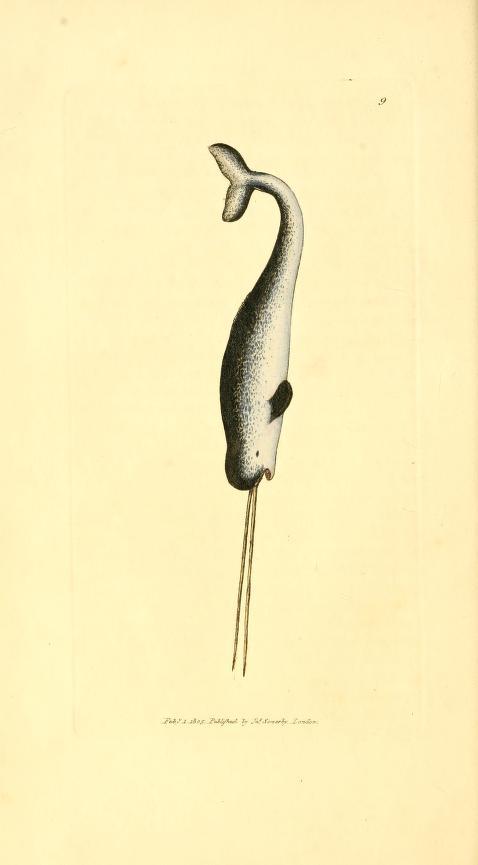
George Shaw's The British Miscellany (1806)
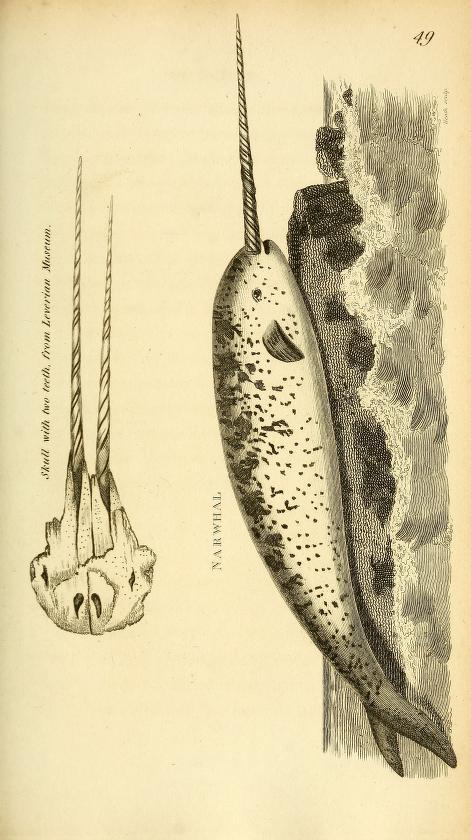
George Shaw's Zoological Lectures (1809)
Bonus: Found a photo I took of a real double-tusked #narwhal skull that was on display at the Smithsonian NMNH :

#animals in art#animal holiday#european art#19th century art#illustration#narwhal#cetaceans#Narhwal Day#Narwhal Appreciation Day#George Shaw#British art#English art#natural history art#scientific illustration#historical sciart#sciart#book plate#museum visit#exhibiton#skull
31 notes
·
View notes
Text
"The Arctic's iconic narwhal, renowned for its long, spiral tusk, is one of nature's most fascinating creatures. Yet, few have witnessed how these elusive animals use their tusks in the wild."
3 notes
·
View notes
Text
i love how simple and descriptive and exciting some latin names are. megaloceros, big horns, oh hell yeah. megatherium, giant beast yesss. even monodon monoceros, one tooth one horn, i’m intrigued.
#post i made#zoology#natural history#extinct animals#in order these are irish elk- giant sloth- narwhal btw
29 notes
·
View notes
Text
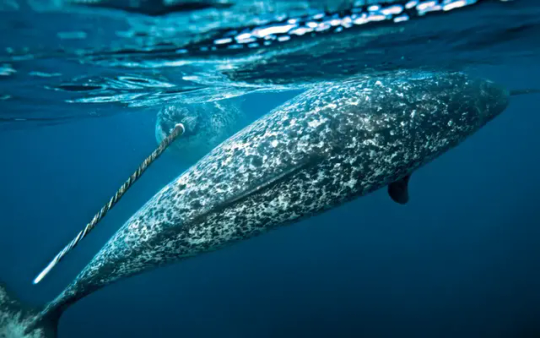
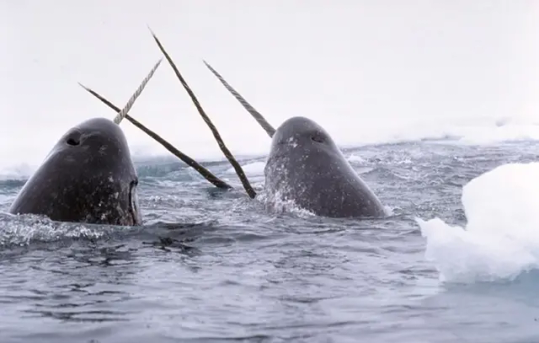

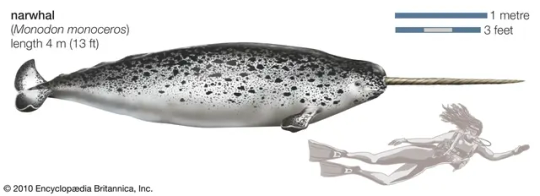


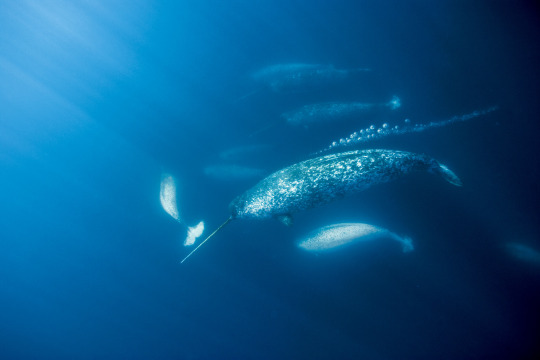
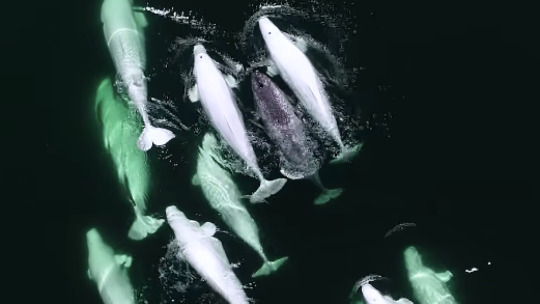

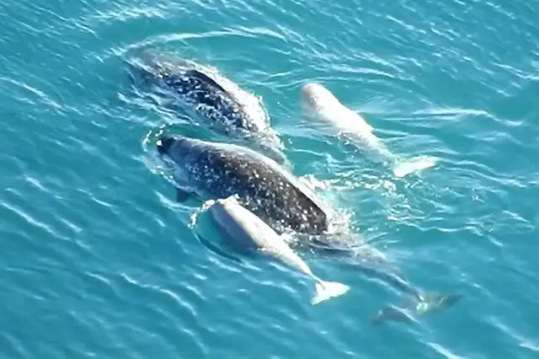
Monodon monoceros, better known as the narwhal, is a species of toothed whale in the family Monodontidae and the only living member of the genus monodon, and is endemic to the frigid waters of the far northern atlantic, the far northern pacific, and the arctic oceans. They live in pods of 5 to 20 individuals, with individuals frequently switching between groups depending on the time of year (in calving season nursery pods are formed of primarily females and there young, during such time adolescents join with bull males to form there own pods), in some cases several pods may come together for short periods of time forming aggregations up to 1,000 whales. Narwhals are some of the deepest swimming mammals, regularly diving upwards of 4,900ft (1,500ms) in search of prey such as cod, squid, redfish, wolffish, capelin, cuttlefish, shrimp, skates, and various types of flatfish. Narwhals are themselves preyed upon by polar bears, orcas, Greenland sharks, and humans. Reaching some 10 to 18ft (3 to 5.5ms) in body length, and 1,760 to 3,530lbs (800 to 1.600kgs) in weight, with males being slightly larger than females, narwhals sport a thick cylindrical body and a mottled pigmentation, with blackish-brown markings over a white background. Instead of a dorsal fin, it possesses a shallow dorsal ridge, and female narwhals sport tail flukes that sweep-back on the front edges, whilst those of males curve inwards. The narwhals most notable feature is the single long spiral tusk which projects from the left side of the upper jaw of males and can get up to 10ft (3m) long. Additionally some females may grow tusks and some males may grow two tusks. These tusks seem to have many uses such as: stunning fish, attracting mates, fencing with rivals, sensing temperature and salinity, breaking sea ice, and communication with one another. Breeding occurs from march to may, after a 15 month pregnancy a mother narwhal will give birth to a single calf which remains by there mothers side for 2 to 3 years. Under ideal conditions a narwhal will reach sexual maturity at 6 to 8 years of age and may live upwards of 80.
#pleistocene pride#pleistocene#pliestocene pride#pliestocene#cenozoic#ice age#stone age#narwhal#arctic#whale#beluga#animal#sea#facts
14 notes
·
View notes
Text
January Readings
Articles:
"Approaching the Monstrous: A Few Thoughts on Monster Studies in Taiwan" by Yung-chao Liao
"Beauty and the Enchanted Beast: The Narwhal (Monodon monoceros) in the Canadian Cultural Landscape" by Marie-France Boissonneault
"Bilad al-Brazil: The Importance of West African Scholars in Brazilian Islamic Education and Practice in Historic and Contemporary Perspective" by Ayodeji Ogunnaike
"Debunking an Urban Legend of the Deep Sea: The Queen of the Abyss and her Contribution to Ceratioid Anglerfish Biology" by Toshiro Saruwatari
"The First Russian Voyage Around the World and Its Influence on the Exploration and Development of Russian America" by Alexey V. Postnikov
"'The Hours of the Day and Night Are Ours Equally': Dracula and the Lighting Technologies of Victorian London" by Maria Peker
"The Impact of Hispano-Moresque Imports in Fifteenth-Century Florence" by Timothy Wilson
"Independent Indians and the U.S.-Mexican War" by Brian DeLay
"Information, Industrialization, and the Business of Press Clippings, 1880-1925" by Richard K. Popp
"Living a Dream Life: Creating an Image of a Cookbook Author in Early 2000s Russia" by Elizaveta Litovskaia
"Mapping the Nineteenth-Century Brazilian Returnee Movement: Demographics, Life Stories and the Question of Slavery" by Lisa Earl Castillo
"The Mesolithic and Neolithic in Sudan" by Sandro Salvatori and Donatella Usai
"Pollution, Sci-Fi, and the Sublime" by Simon C. Estok
"The Pseudoplanktonic Crinoid Traumatocrinus from the Late Triassic of Southwest China -- Morphology, Ontogeny, and Taphonomy" by Hans Hagdorn and Xiao-Feng Wang
"Rethinking the Vertical Archipelago: Ethnicity, Exchange, and History in the South Central Andes" by Mary Van Buren
"Saraïde: Une Demoiselle Arthurienne pas comme les Autres?" by Anna Elżbieta Korczakowska
"Seascapes as a Critical Framework in American Sea Literature" by Shin Yamashiro
"Tracing the Cretan Labyrinth: Mythology, Archaeology, Topology, Phenomenology" by Paul A. Harris
"Troy in the Troilus and Criseyde" by Wei-ko Sung
"The Two Voices of Virgil's 'Aeneid'" by Adam Parry
"Vertuous Women Found: New England Ministerial Literature, 1668-1735" by Laurel Thatcher Ulrich
"Victorian Historiography and the Image of China" by Shu Yunzhong Short Stories:
"Ashes of Exploding Suns, Monuments to Dust" by Chris McKitterick
"The Best Policy" by Randall Garrett
"Last Contact" by Stephen Baxter
#forgot to actually publish this#trying to keep track again#we shall see if it lasts#mine#my reading
2 notes
·
View notes
Text

The narwhal, or narwhale (Monodon monoceros)
By: Paul Nicklen
2 notes
·
View notes